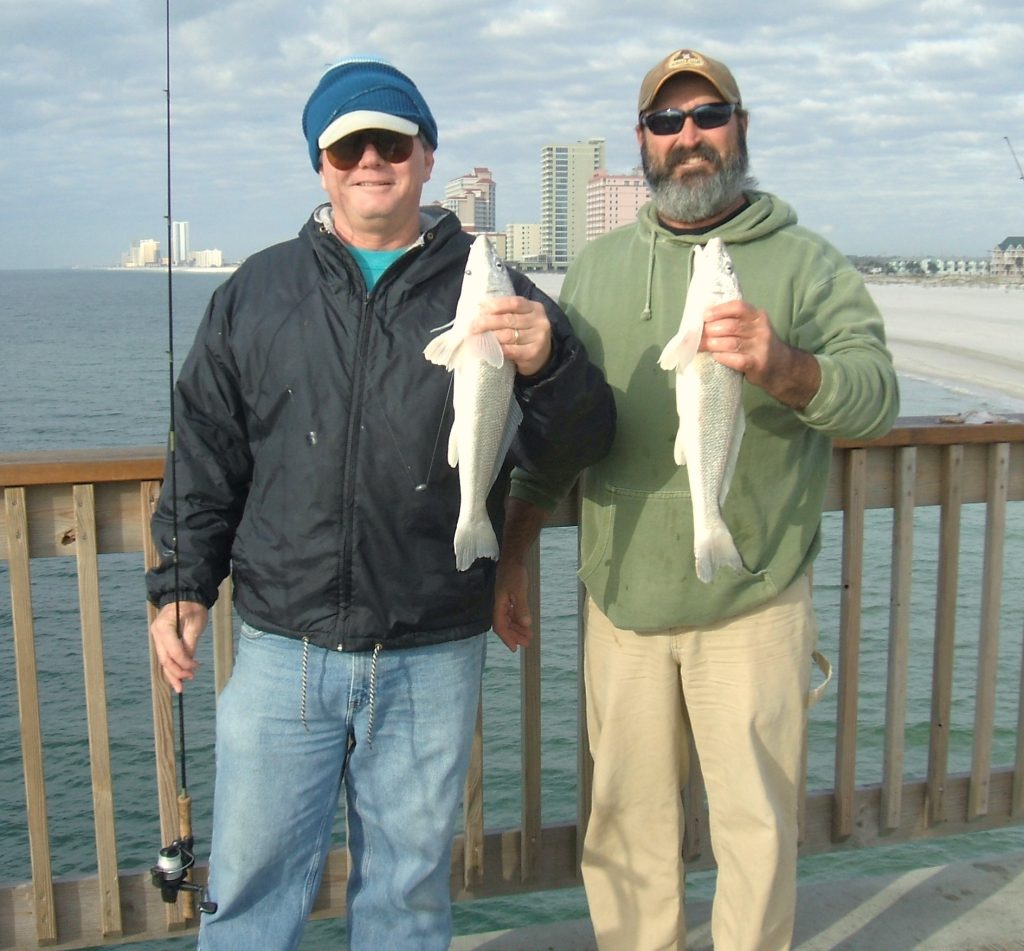Likely the first and most common fish that anglers encounter in the surfzone along the north central coast of the Gulf of Mexico is the Gulf Kingfish (Menticirrhus littoralis), locally referred to as “whiting”. Although “whiting” is a local name often used interchangeably with “ground mullet”, that term usually refers to the two other closely related species in the genus Menticirrhus (Southern and Northern Kingfish). Thus the confusion in what to call each of the three closely related species that are so similar looking. In fact, the state of Alabama does not even differentiate between the species when record keeping. And even though they are also referred to as “kingcroakers” they do not make the characteristic croaking sound of the typical Atlantic Croaker, their distant cousin in the family Sciaenidae which include drums and croakers.
Menticirrhus translates from the Latin words mentum, meaning “chin”, and cirrhus, which means “barbel”. This describes the single appendage under the mouth used in detecting food, often in roiled waters or even in the dark at night. The three species’ Latin name refers to the habitat or location where they are most commonly found: littoris translates roughly to “shore”, americanus means “of the Americas”, and saxatilus means “dwelling among rocks” (or shells). Though all three species are frequently encountered in schools throughout this region, it is unusual to find all three in the exact same location simultaneously. As their binomial names infer, the preferred habitats of kingfish are different enough to keep them mostly separated, though their territories frequently overlap, mainly due to their similar diets of small benthic invertebrates. While the Southern Kingfish prefers deeper channels and bays near the mouth of estuaries (thus the East Coast name “Channel mullet” and Gulf Coast moniker “ground mullet”), the Gulf and Northern varieties are rarely found away from a high salinity surfzone environment.
Whiting Facts
Stock assessments are not generally tracked for the kingfish species, but catch surveys by NOAA show a cyclical abundance relatively coincident to the lifespan of individual fish. This would suggest some years provide stronger spawning cycles of about every three to five years. Though recent recreational anecdotal reports would indicate a downturn in reported kingfish numbers, that could simply be the result of localized depletion around areas that receive the most angling pressure and retention of whiting. From-shore beach and shore guides have noted this effect over the past ten years or so, along with a general increase in angler numbers and prowess. Their answer was to self-regulate their harvest of these unregulated species to no more than ten fish over ten inches per angler per day.
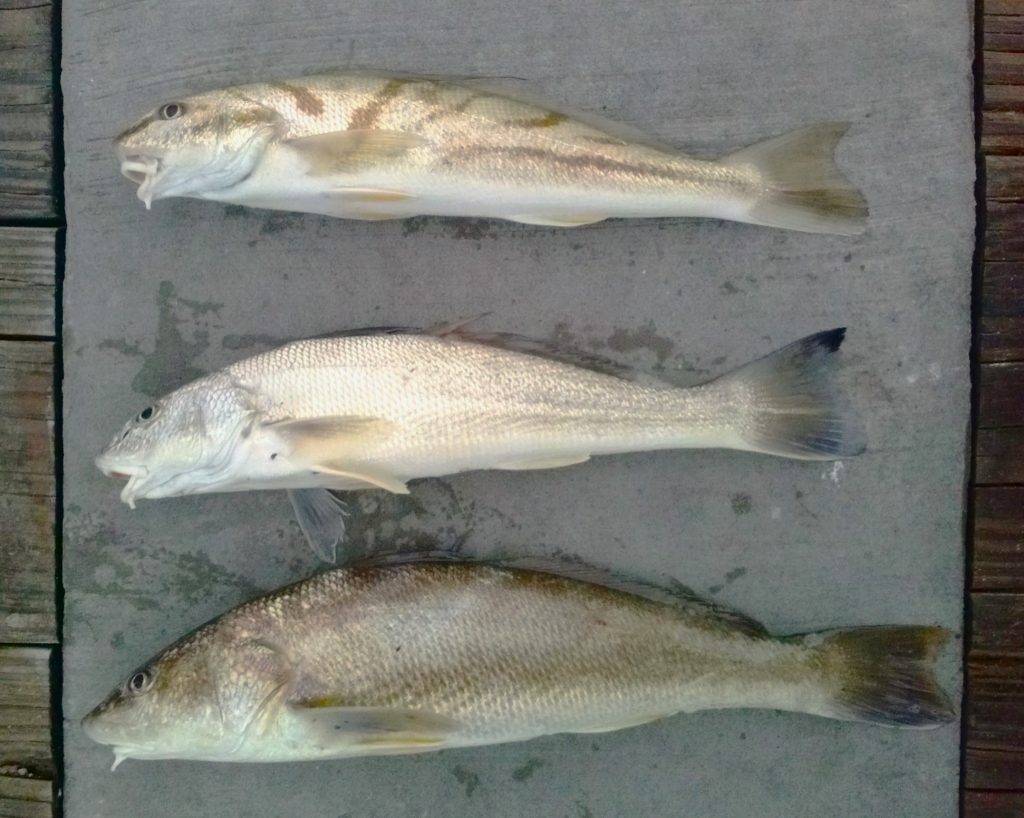
Kingfish grow rather quickly through their first year, averaging almost an inch per month. And most are sexually mature around their first birthday, once they reach eight to ten inches. At that point their growth rate slows markedly, to about one to three inches per year. But they are fairly long-lived, maxing out at over twenty inches in eight to ten years. Though the numbers of larger length individuals decreases almost exponentially each year, as they are heavily predated upon by bluefish and other toothy fish as well as animals like loons and dolphins, not to mention shore-bound anglers.
How Big Do Whiting Get?
The IGFA record Kingfish, listed as M. littoralis, weighed in at three pounds, thirteen ounces, and was caught in 2020 in North Carolina. IGFA lists the record M. americanus as two pounds, thirteen ounces (2002 from Virginia Beach, VA), and the record M. saxatilis as two pounds, thirteen ounces (from North Carolina in 2002).
As mentioned previously, Alabama does not differentiate between the Gulf and Southern species, but records two pounds, sixteen ounces (three pounds?) as the record (caught April 9, 2001). Florida’s latest record whiting/kingfish is 2.8 pounds caught from Santa Rosa Beach in 2021. And Mississippi records M. littoralis at two pounds zero ounces (in 2014), and M. americanus at 2 pounds 0.84 ounces (in 2017).
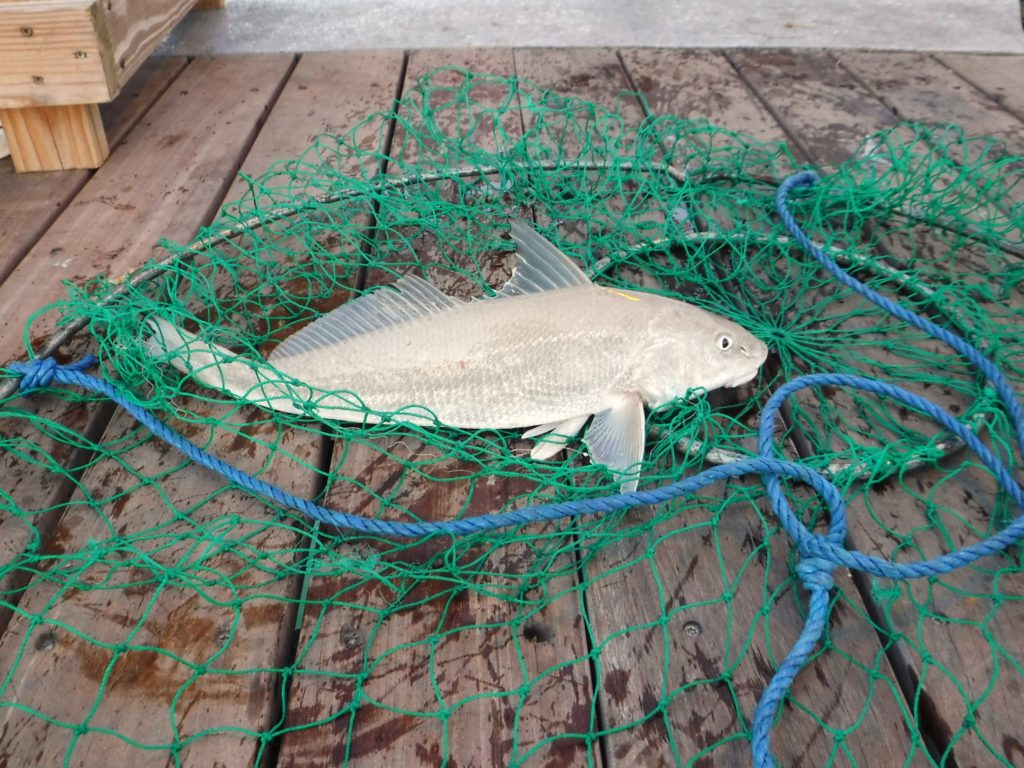
About twelve inches is the average size for most whiting, when they are between two and three years old. Near fourteen inches long, kingfish weigh around a pound and are between three and four years old. At sixteen to seventeen inches kingfish weigh about one-and-a-half pounds and are over five years old. And a two pound whiting is usually nineteen to twenty inches long, and probably seven years old, or more.
Where To Find Kingfish
The Gulf Kingfish is well adapted to the harsh littoral environment, spending its lifespan fighting strong waves, currents, and numerous predators both in the water and out. They are easily identified by their gray back, silvery sides and white belly, but mostly by their tell-tale black spot on the tip of the tail. This distinctive marking is likely a defensive measure evolved to confuse predators, tricking them into mistaking the tail of the fish for its head. The Southern and Northern varieties have angular dark gray lines on their sides and no black tip on their tail. The Northern Kingfish also sports a characteristically long, dark colored dorsal fin.
The Gulf and Northern Kingfish are most often found in the surfzone in relatively shallow water, seeking refuge from water-bound predators, resting, or feeding on benthic invertebrates such as sand fleas, beach ghost shrimp, coquina clams, and augers. As the water calms and gets clearer between storm systems, and in bright daylight, these kingfish generally move into slightly deeper water. The schools tend to meander into any longshore current that may be available. So, whenever a sideshore wind is sustained long enough, or strong enough to create wind driven currents, feeding kingfish tend to orient and move into it. Often the key to an angler finding them is to fish along a sandbar dropoff where food items may be swept off the bar into relatively deeper water. The kingfish, and perhaps other predatory fish such as pompano, small redfish or drum, flounder, bluefish and even speckled trout stage just below these edges where their hapless food items are pushed, so they can avoid the full force of the current.
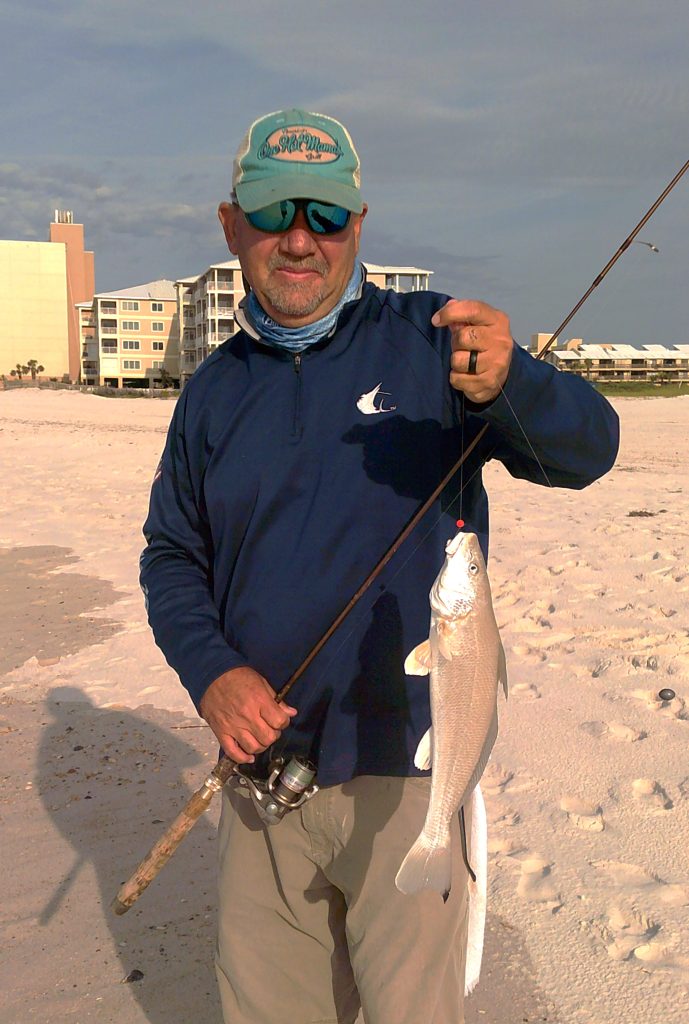
Often this feeding window is triggered by changes in the tide level and direction, which depending on the water depth in the trough provide relative safety for kingfish to feed in. They only need a couple of feet on an incoming tide, but perhaps twice that on the outgoing tide when they fear being stranded and an easy meal for shore patrolling herons.
Kingfish often feed along deeper sandbar drop-offs too, especially along the longshore sandbar whenever waves or currents potentially push prey items to them. Plus they tend to feed around the edges of beach points where the bottom profile gradually gets deeper, especially as the tide rises. Finding kingfish feeding on points is generally more difficult as they tend to spread out where there is only a gradual change in water depth. The same goes when they are feeding in a trough, near or far from shore, where the bottom depth usually only changes gradually. So if you can locate a shelf edge in deeper water, usually indicated by a color change, that might be a good money spot.
How To Catch Gulf Kingfish
Lures are not commonly used to target kingfish, though larger specimens may be caught occasionally on bottom hugging jigs (like the Goofy jig), or weighted Gulp shrimp in the 2 ½ or 3 inch sizes. Also, the proclivity of all three kingfish species to readily bite Fishbites is well noted and widely exploited by pier and shore anglers.
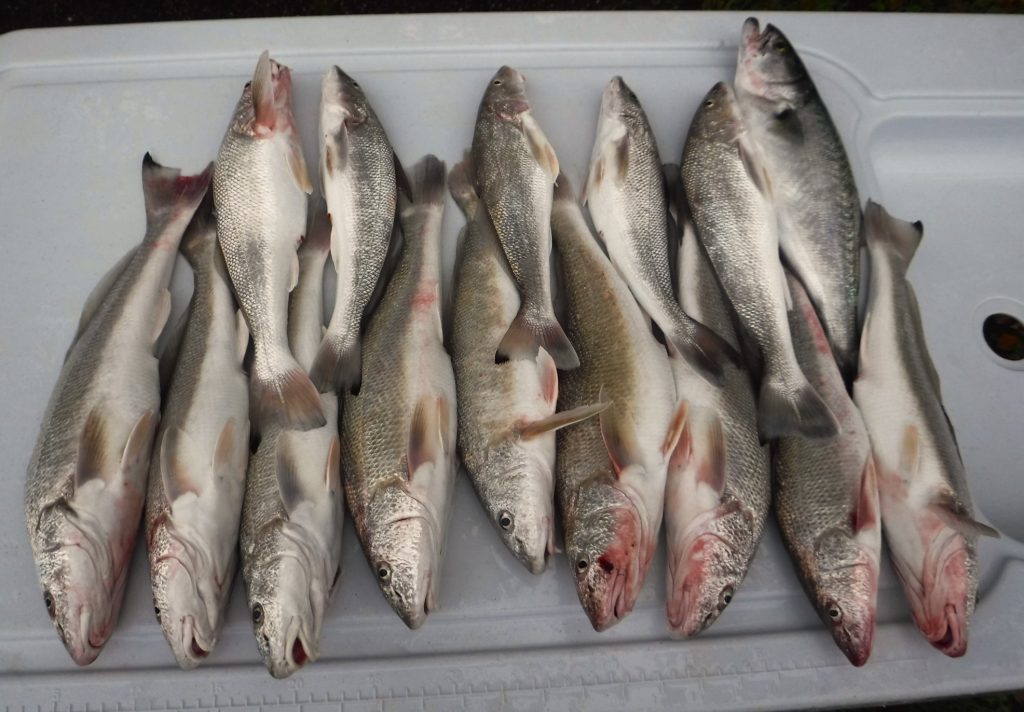
Fresh dead shrimp, cut up in thumbnail sized pieces, very closely mimics mouth-sized sand fleas that kingfish feed upon most when the water temperature is above seventy degrees, while ghost shrimp or beheaded fresh shrimp smaller than your little finger make a good bait the rest of the year. A mistake many anglers make is using too big a piece of bait that exceeds how much a kingfish can fit into its mouth. Their characteristic feeding habit is to approach the bait cautiously, and strike to stun it. Then they circle around to line up the bait and suck it into their mouth. The best time to strike is as they swim away. A small, #6 kahle single hook is very effective for this method. But the type of bait, hook style and size, along with the presentation type, and amount and style of weight used can be altered to determine the most effective under the circumstances encountered. Kingfish are very wary, even finicky, and will scatter when a heavy weight splashes down nearby. Many times in calm, clear water, a light or ultralight presentation will be most effective, and fun! Experimentation and results between Carolina rig versus Fishfinder rig, single drop or double drop, become more evident as an angler gains more experience with each method. Fishbites also offers a premade Whiting fish rig.
The Future Of Gulf Kingfish
Fortunately for kingfish, and anglers, they are quite prolific. They spawn throughout much of the year, while the water temperature is above seventy degrees (April to November). This assures their relative abundance, thus kingfish are not currently regulated and only rarely commercially harvested.
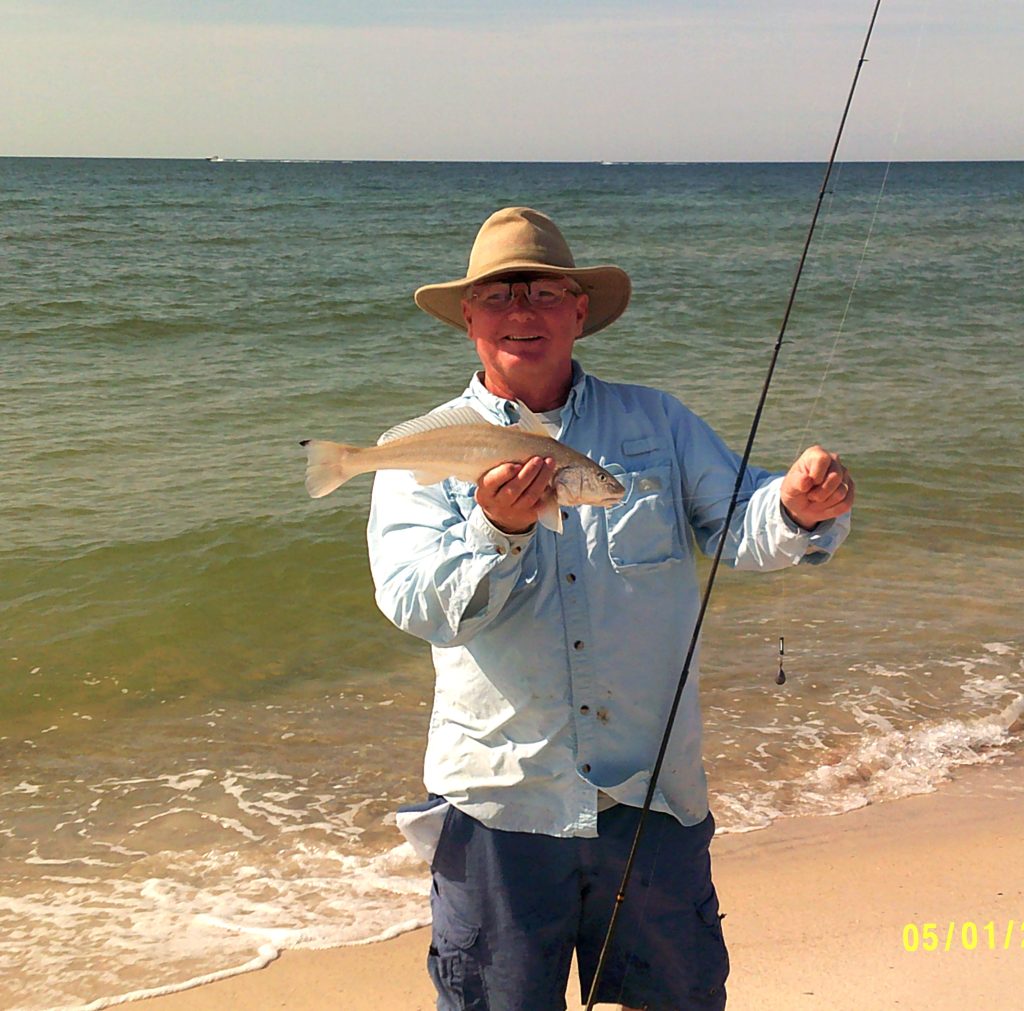
Like many other fish species found in the Gulf, smaller mature kingfish are most often males, and the larger specimens are most likely females. The relative fecundity (ability to reproduce each year) of kingfish is directly proportional to the size of the fish. Thus the number of eggs produced by a 16 inch kingfish (4 or 5 years old) may be more than twice that of each 12 inch (1 year old) kingfish breeding for the first time.
Problem for the kingfish is the size of the fillets are relative too. Thus anglers are tempted to keep and eat every large kingfish they catch, because they are so darn delicious. So that means from-shore anglers must be responsible enough when harvesting them for food or bait to assure they never are regulated, and that kingfish continue to remain abundant throughout the region for generations to come.

